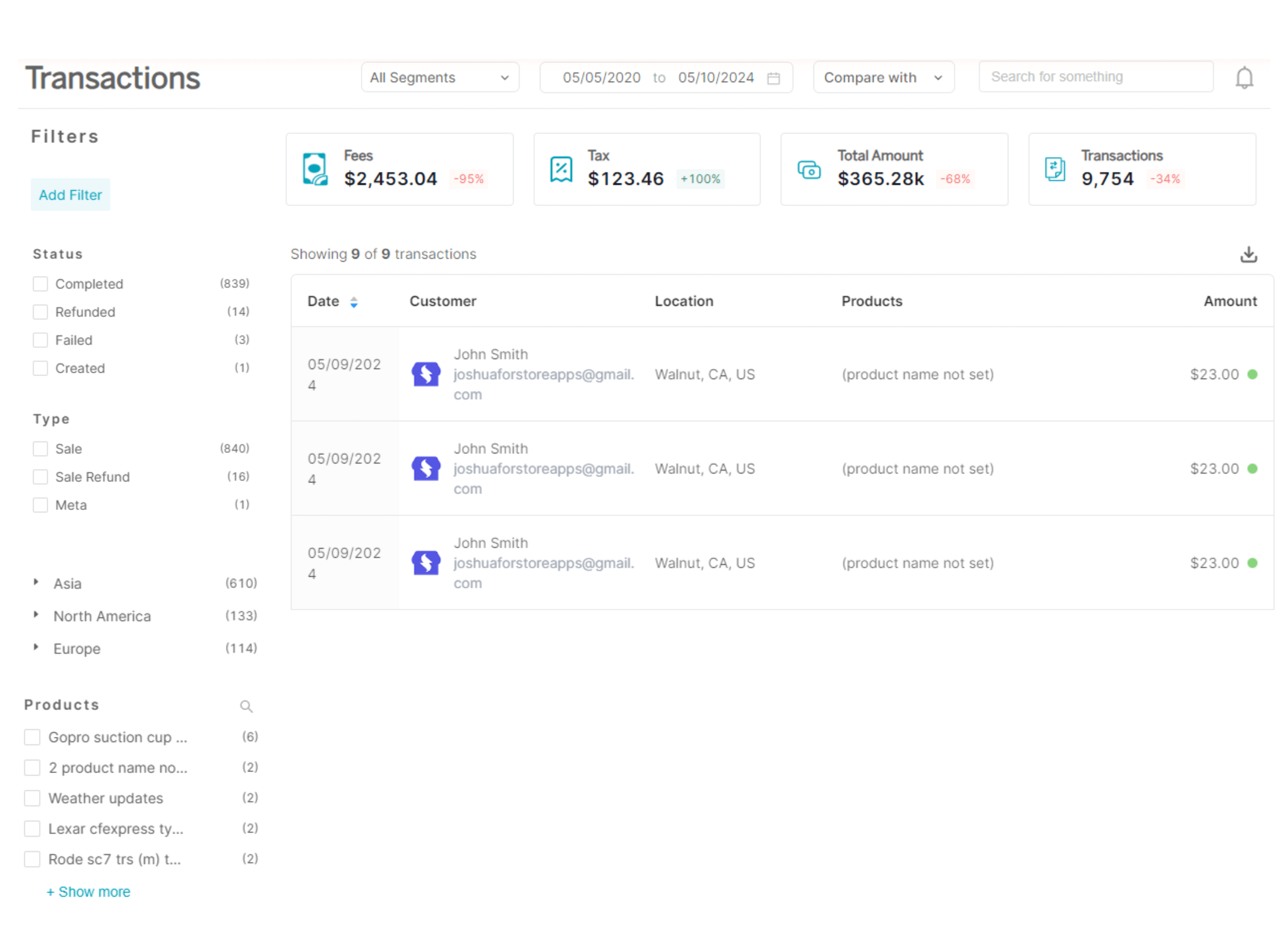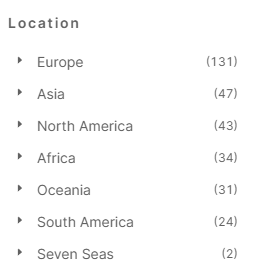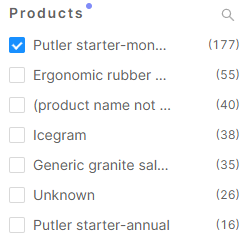Transactions Dashboard
Overview

Putler's Transactions Dashboard offers an in-depth look at your business's financial activities, helping you track sales, fees, taxes, and more. By consolidating data from various sources, Putler provides a clear and comprehensive view of your transactions, making financial management simpler and more efficient.
Predefined Filters (Facets)
Putler's Transactions Dashboard includes powerful filtering options to help you analyze data based on specific criteria. Below are the filter categories you can use:
Segment customers based on location

Introduction
Allows you to filter transactions by geographical location, providing insights into sales performance across different regions.
You can filter transactions right to the street level.
How to use this metric?
Suppose you want to see how your business is performing in different parts of the world. By filtering transactions by location, you can identify where your products are most popular. For instance, you notice that Europe has 121 transactions, significantly higher than other regions. This insight helps you tailor marketing strategies to boost sales in underperforming areas.
Benefits
- Regional Insights: Understand how sales vary across different locations.
- Targeted Marketing: Tailor your marketing efforts to regions with higher sales potential.
- Performance Analysis: Compare performance between regions to identify growth opportunities.
Segment transaction based on Products

Introduction
Allows you to filter transactions based on specific products, helping you analyze sales performance for each item.
How to use this metric?
If you're launching a new product, it's important to track its performance. By using the product filter, you can see how well each item is selling. For example, the "Ergonomic rubber pants" have 9 transactions, while the "Generic granite salad" has 8. This data helps you understand customer preferences and plan inventory more effectively.
Benefits
- Product Performance: Monitor sales for individual products.
- Inventory Management: Ensure popular items are always in stock.
- Customer Preferences: Understand which products are favored by customers.
Segment transaction based on Status
Introduction
Allows you to filter transactions by their completion status, helping you focus on completed sales or pending transactions.
How to use this metric?
As a business owner, you might want to review only the completed sales to analyze actual revenue. By applying the status filter to show completed transactions (40 in this case), you can focus on the confirmed sales data. This helps you get a clearer picture of your actual earnings without the noise of pending transactions.
Benefits
- Revenue Analysis: Focus on completed sales to understand actual revenue.
- Operational Efficiency: Identify and address any issues with pending transactions.
- Financial Planning: Use accurate data for better financial forecasting.
Segment transaction based on Type
Introduction
Allows you to filter transactions by their type, such as sales, to focus on specific aspects of your business operations.
How to use this metric?
If you want to analyze only the sales transactions to understand revenue streams better, you can use the type filter. For instance, filtering by "Sale" will show you all sales transactions. This helps you focus solely on sales data, making it easier to analyze revenue performance and identify trends.
Benefits
- Focused Analysis: Concentrate on specific transaction types for detailed insights.
- Revenue Tracking: Better understand your sales revenue streams.
- Trend Identification: Identify patterns and trends in sales transactions.
Transaction Metrics
Fees
Introduction
The total fees incurred for all transactions during the selected date range. This includes fees from various payment gateways and e-commerce platforms, covering platform fees and any additional charges passed from inbound sources.
How to use this metric?
Imagine you run an online retail store. Keeping track of transaction fees is crucial to understanding your costs and managing your budget effectively. Last month, you incurred $500 in fees. By monitoring these fees, you can see how much of your revenue goes towards transaction costs and plan accordingly.
Benefits
- Expense Management: By tracking fees, you can monitor and control the costs associated with each transaction.
- Cost Analysis: Understanding how much you spend on fees helps you evaluate their impact on your overall revenue and identify ways to reduce costs.
Taxes
Introduction
The total taxes incurred for all transactions during the selected date range.
How to use this metric?
For a small business owner, staying compliant with tax regulations is essential. By using Putler, you can track the total taxes incurred from your transactions. For instance, your business incurred $1,200 in taxes last quarter. This detailed tax data aids in accurate tax reporting and financial planning, ensuring you set aside the right amount for tax payments.
Benefits
- Tax Compliance: Accurate tracking of taxes helps ensure you are compliant with tax regulations.
- Financial Planning: Knowing your tax liabilities allows for better cash flow management and budgeting.
Total Amount
Introduction
The total amount represents the sum of all transactions within the chosen date range, including net revenue, refunds, shipping, taxes, fees, discounts, and commissions.
How to use this metric?
As an entrepreneur, you need to know your total sales to assess your business's performance. Suppose your store made $50,000 in sales last month. This figure gives you a comprehensive view of your revenue, helping you understand your business's financial health and plan for future growth.
Benefits
- Revenue Tracking: Keep an eye on your total sales to understand your business’s income.
- Performance Analysis: Assess your business’s overall financial health and make informed decisions for future growth.
Transactions
Introduction
The total number of transactions completed during the selected date range.
How to use this metric?
If you manage a subscription service, tracking the number of transactions is key to understanding customer activity. For example, your service completed 1,000 transactions this month. This high transaction volume indicates strong customer engagement and helps you gauge the effectiveness of your marketing strategies.
Benefits
- Activity Monitoring Track the volume of transactions to see how busy your business is.
- Growth Analysis Measure customer interaction and business expansion through transaction volume.
- Customer Service: Provide quick and efficient refunds, enhancing customer satisfaction.
- Subscription Management: Manage subscriptions seamlessly, improving operational efficiency.
Transactions List View

Introduction
A comprehensive list of all transactions for the selected date range, marked with green for sales and red for refunds. This list can be exported as a CSV file.
How to use this metric?
For a business owner, reviewing transactions at a glance is invaluable. Suppose you need to prepare a financial report. Using the Transactions List View, you can easily review all sales and refunds for the month. Exporting this list as a CSV file allows for detailed analysis and helps in preparing accurate financial reports.
Benefits
- Data Review: Quickly review all transactions to monitor sales and refunds.
- Export Capability: Easily export transaction data for detailed analysis and reporting, aiding in financial planning and audits.
Summary
By leveraging Putler’s Transactions Dashboard and its robust filtering options, you gain a thorough understanding of your financial activities.
This tool not only simplifies tracking sales, fees, and taxes but also empowers you to make informed decisions, optimize your business operations, and enhance financial performance.
You can also view this document, which provides more guidance on the Transaction dashboard and its metrics.